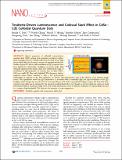Terahertz-Driven Luminescence and Colossal Stark Effect in CdSe–CdS Colloidal Quantum Dots
Author(s)
Zhao, Xiaoguang; Zhang, Xin; Pein, Brandt C; Chang, Wendi; Scherer, Jennifer Marie; Coropceanu, Igor; Bulovic, Vladimir; Bawendi, Moungi G; Nelson, Keith Adam; ... Show more Show less
Downloadacs.nanolett.7b01837.pdf (2.173Mb)
PUBLISHER_POLICY
Publisher Policy
Article is made available in accordance with the publisher's policy and may be subject to US copyright law. Please refer to the publisher's site for terms of use.
Terms of use
Metadata
Show full item recordAbstract
Optical properties of colloidal semiconductor quantum dots (QDs), arising from quantum mechanical confinement of charge, present a versatile testbed for the study of how high electric fields affect the electronic structure of nanostructured solids. Studies of quasi-DC electric field modulation of QD properties have been limited by electrostatic breakdown processes under high externally applied electric fields, which have restricted the range of modulation of QD properties. In contrast, here we drive CdSe-CdS core-shell QD films with high-field THz-frequency electromagnetic pulses whose duration is only a few picoseconds. Surprisingly, in response to the THz excitation, we observe QD luminescence even in the absence of an external charge source. Our experiments show that QD luminescence is associated with a remarkably high and rapid modulation of the QD bandgap, which changes by more than 0.5 eV (corresponding to 25% of the unperturbed bandgap energy). We show that these colossal energy shifts can be explained by the quantum confined Stark effect even though we are far outside the regime of small field-induced shifts in electronic energy levels. Our results demonstrate a route to extreme modulation of material properties and to a compact, high-bandwidth THz detector that operates at room temperature.
Date issued
2017-09Department
Massachusetts Institute of Technology. Department of Chemistry; Massachusetts Institute of Technology. Department of Electrical Engineering and Computer ScienceJournal
Nano Letters
Publisher
American Chemical Society (ACS)
Citation
Pein, Brandt C. et al. “Terahertz-Driven Luminescence and Colossal Stark Effect in CdSe–CdS Colloidal Quantum Dots.” Nano Letters 17, 9 (August 23, 2017): 5375–5380 © 2017 American Chemical Society
Version: Final published version
ISSN
1530-6984
1530-6992